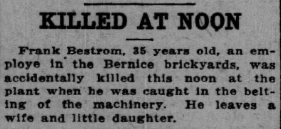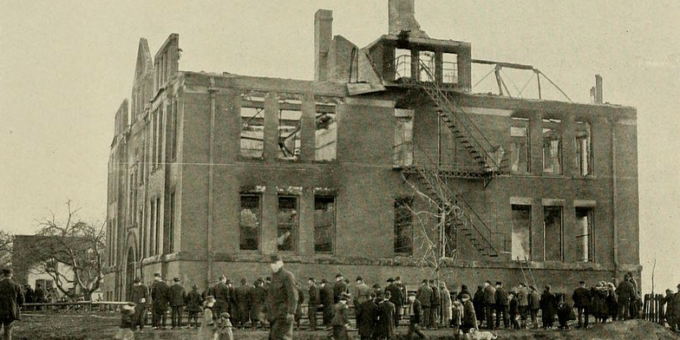
It was 9 am, March 4, 1908, and the children of Lakeview School in Collinwood, Ohio were sitting in their classrooms when the fire alarm went off. Teachers lined up their children, just as they had taught them to do during the fire drill, and headed towards the front door. But the front door was blocked by smoke and flames. The children had to make their way to the back staircase and exit through the only other door in the three story building.
The children, scared and disoriented, began to panic. They fell over each other as they tried to reach the back door. Their little bodies piled up and, packed in tight in the little stairway, they were unable to escape the building.
Roughly half of the school children managed to escape the fire through broken windows. The rest, 172 students between the ages of six and fifteen, perished in the fire. Two teachers also died.
It took less than an hour for the school to burn down and all three floors collapsed into the basement.
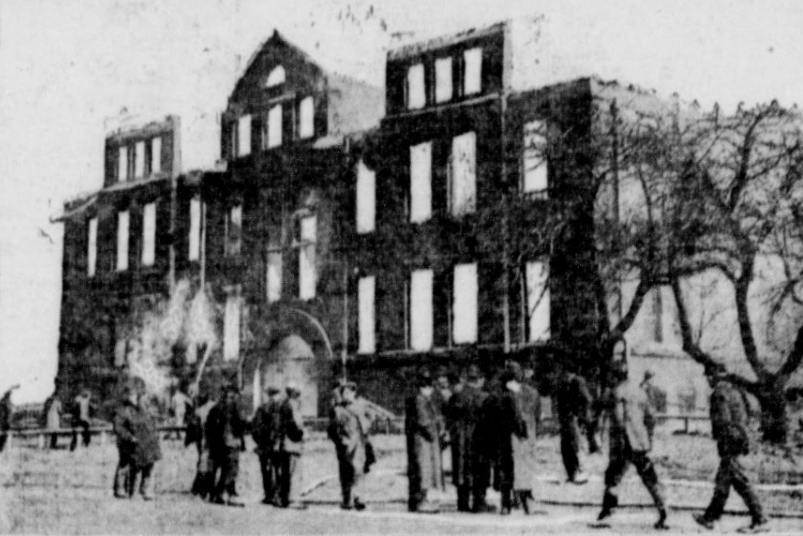
1. The Cause of the Fire
Initial reports about the school fire explored the possibility of arson, but there was no evidence that someone maliciously started the fire.
A story was published that several children were seen playing near the area where the fire was believed to have started. It could have been an accidental fire or maybe the children were smoking cigarettes, but that, too, seemed unlikely.
The janitor, Fred Hirter, was also initially blamed for not getting all the children out of the building, but he, too, suffered a loss in the fire. He recounted:
“I was sweeping in the basement when I looked up and saw a wisp of smoke curling out from beneath the front stairway. I ran to the fire alarm and pulled the gong that sounded throughout the building. Then I ran first to the front and then to the rear doors. I can’t remember what happened next, except that I saw flames shooting all about and the little children running down through them screaming. Some fell at the rear entrance and others stumbled over them. I saw my little Helen among them. I tried to pull her out, but the flames drove me back and I had to leave my little child to die.”
On March 12, the coroner removed all blame that had been placed on the janitor. According to an investigation of the scene, the fire was believed to have been caused by overheated pipes that ignited dry wood under the front stairway.
The boiler might also have been the cause of the fire, but researchers today are still uncertain about how the fire was actually started. [Sources 1, 2]
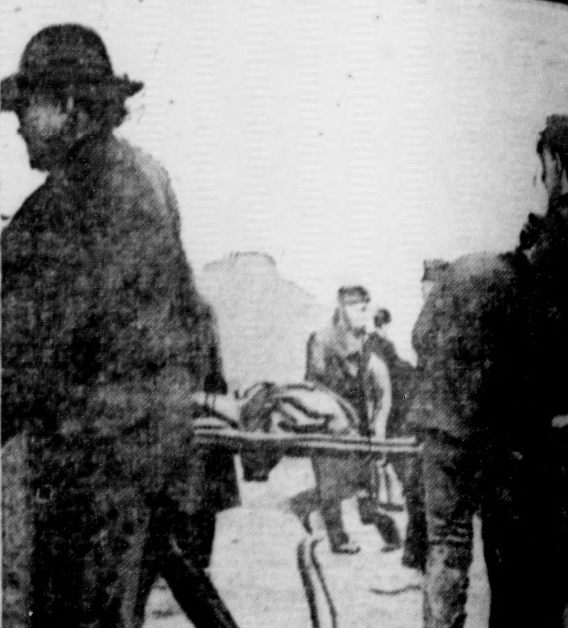
2. Bottlenecked and Piled Up
The youngest children were on the second floor of the school house and there were only two narrow staircases inside the building. The one led to the front door that was blocked by fire. The other staircase led to the back door. Initial reports said that the back door might have been locked, although later reports state that the school janitor had opened the door so that children could escape.
Previous to the fire, fire drills had been practiced, but the children were only taught how to leave through the front door. The youngest children did not know how to exit out the back.
Most of the children who died in the fire were killed in the back stairway. When their little bodies were found, they were in a large pile.
Miss Gollmar, one of the teachers who managed to escape, said:
“It was awful. I can see the wee things in my room holding out their tiny arms and crying to me to help them. Their voices are ringing in my ears yet, and I shall never forget them. When the alarm gong rang, I started the pupils to marching from the building. When we started down the front stairs we were met by a solid wall of flame and clouds of dense smoke. We retreated, and when we turned the children became panic stricken and I could not do anything with them. They became jammed in the narrow stairway, and I knew that the only thing for me to do was to get around to the rear door if possible and help those who were near the entrance. When I got there after climbing out of a window, I found the children so crowded in the narrow passageway that I could not pull even one of them out. Those behind pushed forward and as I stood there the little ones piled up on one another. Those who could stretched out their arms to me and cried for me to help them. I tried with all my might to pull them out and stayed there until the flames drove me away.” [Source 3]
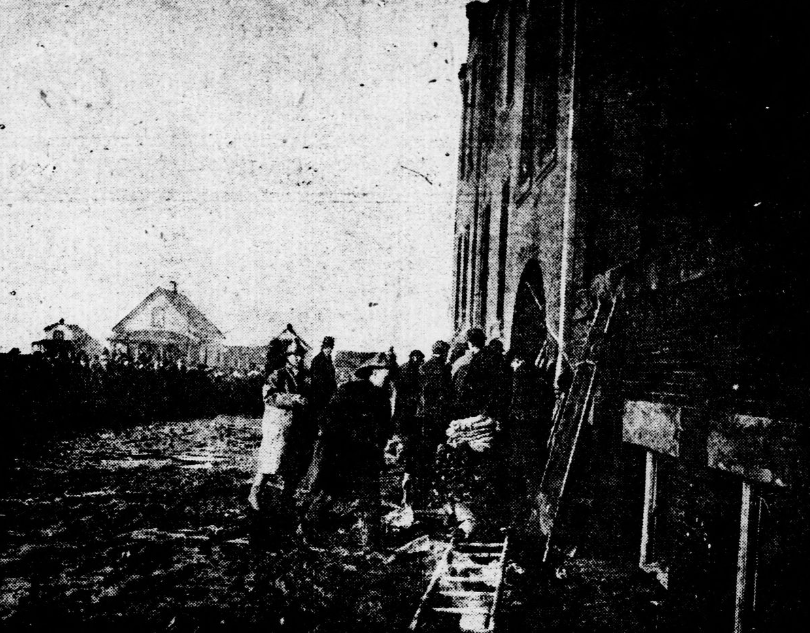
3. A Last Goodbye
Miss Golmar was not the only person trying to pull the children from the building. Nearby parents came running to the school and did what they could to help.
According to one heart wrenching report:
“Little children were piled upon each other six and eight deep while strong men and frantic mothers struggled with desperation to release them, yet failed, and were compelled to stand back and see the little ones die before their eyes. One woman found her daughter in this press and stroked her hair in an effort to keep the flames away. She failed and the child was burned to death while her mother looked on.”
After the tragedy, there were numerous reports of mothers suffering from their loss. A few had lost the will to live and there were attempts on their own lives. [Source 4]
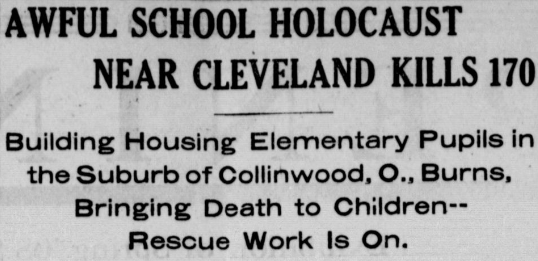
4. Went Back in to Save His Brother
Niles Thompson could have been one of the lucky children who escaped the fire. After the fire broke out, the nine-year-old escaped through a window. He ran to the other children and began looking for his little brother. He could not find him. Thomas would have been on the second floor.
Fear and impending loss must have overwhelmed the child and he did what he believed he had to do. Niles ran back into the burning school, determined to find his little brother, but he never returned. Both Niles and little Thomas were lost forever. [Source 5]
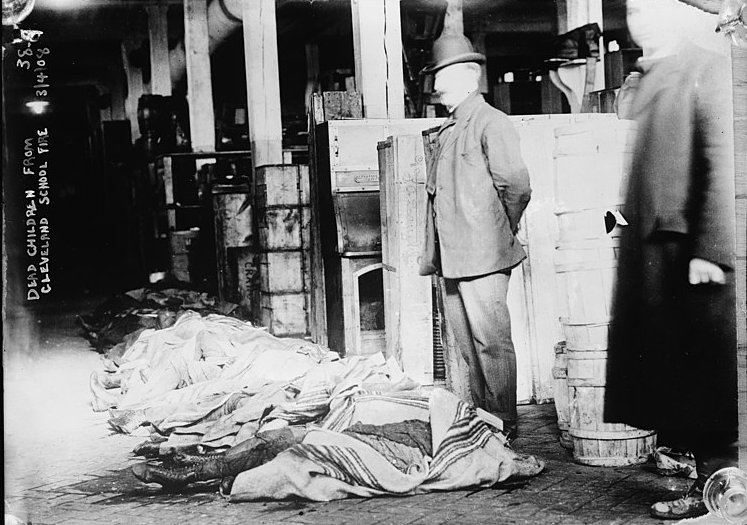
5. Identifying the Dead
Firemen and railroad employees took on the task of removing the dead from the basement. As each body was taken from the ruins of the school, it was placed in a makeshift morgue. The bare building was a railroad shop, donated for use by the railroad company, and it was the only place that could hold the initial 162 bodies that were removed within the first five hours after the fire.
One article reported:
“The gruesome task of taking out the torsos and bits of human remains was one of horror. A line of rescuers was formed, backed by half a dozen ambulances. As the bodies were untangled from the debris, they were passed along to the stretchers and thence loaded in the ambulances. Mercifully covered with blankets, the pitiful sights were veiled from the crowd of curious people gathered about the entrance to the structure. As fast as a load was obtained, it was driven away to the improvised morgue.”
The children were laid out in rows as the parents gathered outside the building. After the final child was laid in place, attendants opened the doors and accompanied the parents as they walked among the little bodies on the floor. Men and women sobbed as they identified their children. Some of the children were so badly burned that no one could identify them.
Outside and throughout the town, newspaper reporters wrote that parents could be heard sobbing inside their homes over the lost children. Even the parents whose children made it out alive fell victim to the sadness of so much loss. [Sources 6, 7]
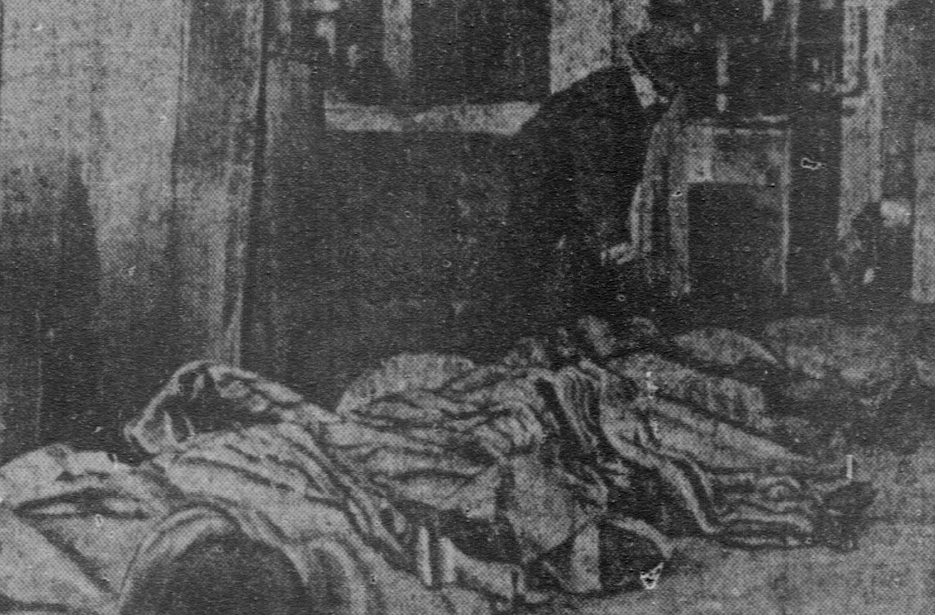
6. Shoes and Jewelry
Mrs. Machnich walked the aisles of charred bodies, looking for her missing daughter, little Rosetta. Those who still had recognizable facial features were unfamiliar to her and she was forced to look at the bodies of those who were badly charred. One by one, she examined them, looking for something that might identify her daughter. And then she saw it. Her daughter’s shoes were the only recognizable item on her child. She threw herself down upon the little form and wept.
This was a common scene throughout the day as parents tried to find the bodies of their children. Often, it was a necklace or a ring that helped identify a child, but shoes also helped in naming many of the young ones. [Source 8]
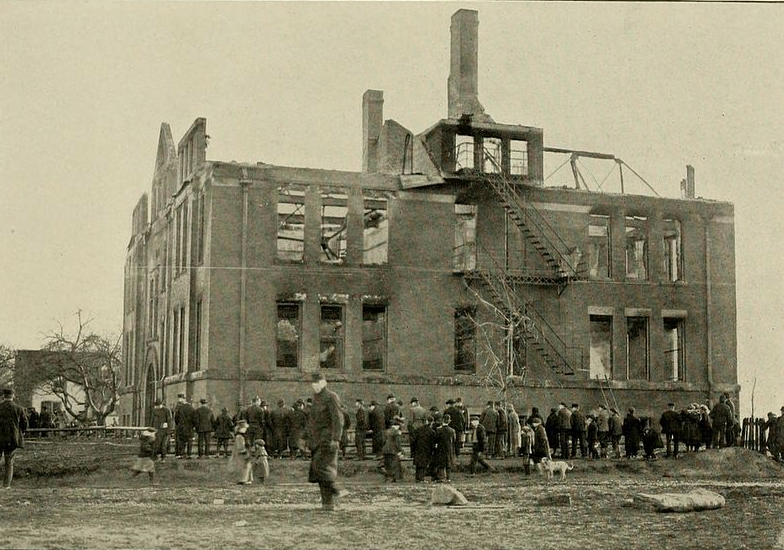
7. The Last to Die and Some Still Missing
When the fire broke out, eight-year-old Glen Barber panicked like everyone else. He must have known that he would not be able to get out of the building through one of the exits in time so he took his only other option. He jumped out of a second story window, but the damage to his little body was severe.
Glen Barber is listed as the final victim of the fire. He passed away just three days after the fire from injuries sustained when he jumped from the window.
On that day, March 7, 1908, forty funerals were held for the lives lost in the fire, but not all the bodies had been recovered from the school’s basement. Six children were still missing.
The school’s superintendent went house to house, visiting every parents who had a child in the school. His research showed that 172 children were either dead or missing. At this time, twenty-one of the bodies recovered were unidentified. [Source 9]
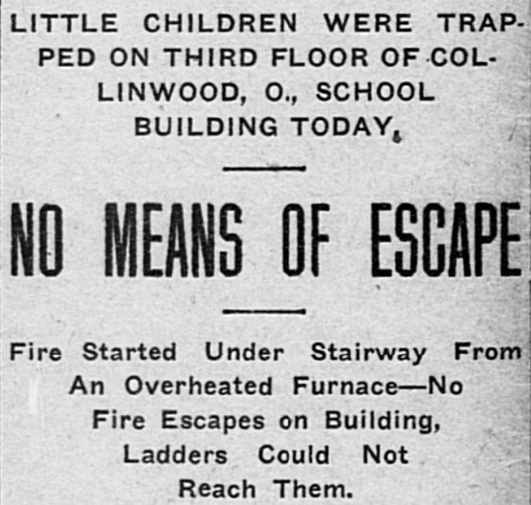
8. Possible Wrong Identification
Two teachers were missing after the fire, and the initial attempt to identify one of them proved troubling. Among the small bodies were the charred remains of a person with a gold filling. Three days after the fire, a missing teacher’s dentist was contacted and he described the gold filling in Miss Katherine Weiler’s mouth.
Miss Weiler taught the smaller children on the second floor. When the fire alarm went off, it was reported that she lined her children up, just as they had previously practiced during the fire drill, but when they exited the classroom and realized that this was not a fire drill, the children panicked. They tried to take the stairs, but were caught in the mass of panicking children that had piled up.
What was believed to have been her body in the stairway was later reported to have been wrongly identified. On March 9, five days after the fire, it was reported that the body was that of a man. John Krajnyak had been one of the first rescuers on the scene. He had entered the burning building and succumbed to the fire. After the fire had been put out and the bodies retrieved, it was noted that the man was missing. No one knew that he had perished in the fire until after his remains were identified.
It was then believed that the teacher’s body might never be identified from among the unknowns.
Later reports omit the possible death of the rescuer, and once again the questionable remains were identified as Miss Weiler. [Sources 10, 11]
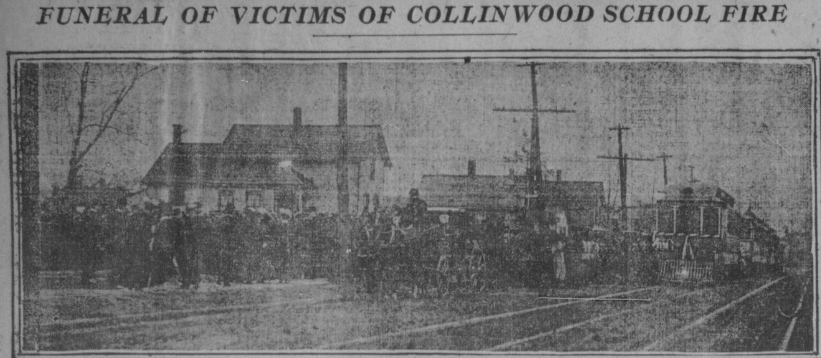
9. Burial of the Unidentified and National Changes
Twenty-one small white caskets lay in a row in what was the temporary morgue. Money had been collected to pay for the burial of the remaining unidentified children. Those children whose parents could not afford a proper burial were included.
The public memorial was given and the crowds gathered around. Police from Cleveland were brought in to help control the crowd. Not only were the people of Collinwood devastated by the fire, but the whole nation mourned.
Parents from across the country were in an uproar over what had happened and what could happen to their own school children.
On March 21, it was reported that:
“One of the indirect results of the terrible Collinwood school fire is the rousing of the public school authorities throughout the country, especially in the larger cities, where the buildings are often veritable fire traps, to take measures for the greater protection of the children from a similar fate. At Cleveland the schools have been closed for two weeks, during which doorways will be altered and fire escapes erected or repaired. Similar measures are being taken by nearly all the cities.”
Parents demanded that new schools be built. Old schools with wooden interiors were being replaced, staircases were being widened, and fire drill practices, as well as fire safety, were being retaught so that the Collinwood school fire would never be repeated. [Sources 12, 13]
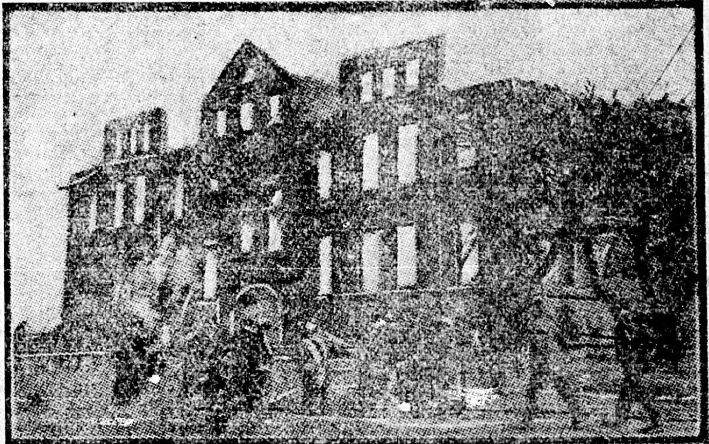
10. Lasting Grief
The Collinwood fire left a lasting wound on the survivors. Over a year after the fire, a group of mothers who lost their children in the fire held weekly meetings. It was during this time that the mothers received what they believed were spirit messages from their young ones.
Louisa Schultz, an 18-year-old who lost her little brother in the fire, believed she received messages from the dead children. At each gathering, the teenaged girl would enter into a trance and write out loving messages from the children to their mothers.
No money appears to have been made from the gathering and it was said that the mothers each held onto their letters, believing that their children were all together up in heaven and were happy. [Source 14]

